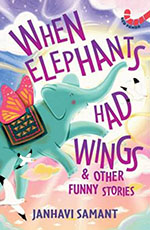It is indeed a special feature of stories that they travel, continuously; passed on from one generation to the next. With time and with the tellers, each story gets a new addition to it, appearing more and more relatable to the listeners. This is particularly true in the case of folk stories, which many times appear familiar to us, despite having heard that particular story for the first time. In this book, Janhavi Sawant has compiled a selection of stories that she was told as a child.
‘ When Elephants had Wings’narrates a legend. It is a simple and crisply narrated story of the troubles caused by elephants’ wings and the ploy that follows to take the wings’ away. It also has a tint of morality.
As the title explains, ‘The Girl who Hated Farts’ is a story about a still tabooed yet quite natural process of farting. The story attempts to convey the latter part through the plot. Kittu, the protagonist, loves her family and has a particular hate for farts. In the course of the hate, what she decides puts her family in worry. This story is full of familiar sounds. The young readers will enjoy the story and it also has a scope for discussion. It reminded me of an anecdote shared by a friend. My friend farts frequently, and their daughter once said, ‘Papa, you fill the whole house with the smell. Please fart outside.’ This anecdote relates to Kittu’s experiences in the story.
‘The Boy who knew No Fear’ is a story of Abhay, who doesn’t fear anything. The story revolves around how this somehow distances him from his family and peers. I realized once again, how the surroundings play a role in shaping a child’s personality. The story also attempts to break stereotypes. But what made me wonder is: why is it always a mother’s job to show her child the ‘right path’?
‘When the Beaches had Flour, Not Sand’is a story based in the southern part of India, on the theme of human greed and exploitation of resources. Murugappa and the other villagers are left with no option but to manage food on their own. The story comments on the nature-human relationship and on the potential risk of food shortage in the near future. Besides, the story also reminded me of a folktale on ‘Why the Oceans are Salty’.
‘The Giant Pumpkin’is quite an imaginative story. The protagonist and a daydreamer Ganya and his wife weave a rather creative yearning about a hefty pumpkin. Pumpkins have been one of the neglected vegetables and the story indeed further validates the same. The way of re-telling is quite interesting; how in folktales, there’s always that one wise individual who puts the misery to end; there’s someone in this story as well. The story reminds me of Man ke Laddoo published by Eklavya.
‘A Tale of Two Siblings’personifies the sun and the moon, weaving a story revolving around both. However, there’s nothing fresh that the story has to offer and is less interesting as compared to the other stories from the collection.
Some of the stories in the collection are about individuals with big hearts and wisdom. For example, ‘Eashwaran’s Generosity’ and ‘The Wise Man who Refused to Lie’. The first one is about how Eashwaran’s wife saves the food and the latter one is about how the eager king fails to make Farooq lie. The queen stands by Farooq the whole time.
The stories such as ‘Lord Ram and the Little Squirrel’, ‘When the Moon Called Lord Ganesha Fat’, ‘The Boy who Saved the Moon from Drowning’, have been re-told on many occasions and there’s a lot written about them too.
There are some stories of courage and struggle, one of which is ‘The Legend of the BrahmaRakshasa’. It narrates how Dadi and Shambhu save the village. This is a traditional story. One may also need to see the connotations of the word Rakshasa in the story. For whom are words such as Rakshasa and Danavas used is the question to ask. The said folk story offers a space to reflect upon this. Another story, ‘The Dragonfly Army’ narrates a conflict between dragonflies and monkeys, bringing out many crucial issues to think about.
Some of the stories expose human foolishness. There are quite a few folk stories in this book narrating such accounts, such as ‘The Three Wasted Wishes’, ‘The Seven Silly Brothers’, ‘TwoStupid Brothers’ and ‘The Man who was Too Proud of His Beard’.
While re-telling these stories, Janhavi has added to the flow to the stories, with her own quite creative writing style. The illustrations help the readers better comprehend the stories.
November 2023, volume 47, No 11

